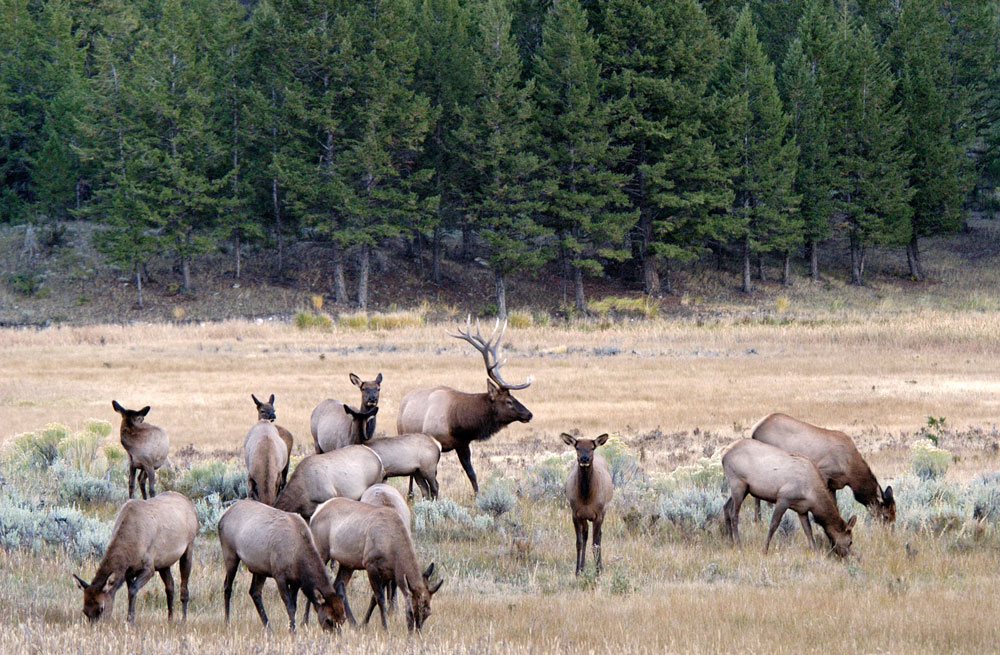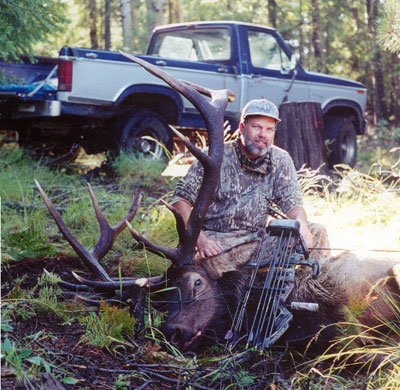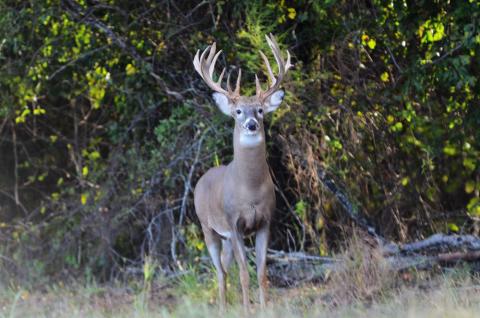Mark Hanson’s First Elk Taken in the Apache-Sitgreaves Area
provided by John E. Phillips
Mossy Oak Pro Mark Hanson from Mesa, Arizona, has a severe case of elk addiction. Mark took his first bull in 1984 with a bow - a spike with brow tines (a legal bull) - that really hooked him on elk hunting. Since then, he’s taken 10 bulls with his bow and two in Colorado with a rifle. However, he’s called in bulls for many friends and family members - about 100 bulls. When Hanson isn’t hunting bull elk to take for himself, he hunts with friends and relatives every year to help record their hunts, find bulls for them, call bull elk and carry out meat.

I primarily hunt in eastern Arizona, near the New Mexico border, south of Alpine, Arizona, just outside of the Apache-Sitgreaves National Forest. In the past, drawing an elk tag was much easier than it is today. Almost all the elk hunts in Arizona are draw hunts. (You go into a lottery, and if your application is drawn, you get a tag to take an elk). There’s a few over-the-counter tags available in certain areas. When I’m asked what I like so much about elk hunting, I like being able to call the elk to me and get inside of their heads. Elk hunting is a lot like turkey hunting. You can get a lot of interaction with a bull elk, even if you don’t harvest him.
The public land I hunt is not far from the White Mountain Apache Reservation, and when the rut kicks in, some of those really big bulls will begin moving off the reservation. When I first started hunting elk in Arizona and New Mexico, drawing a tag wasn’t difficult at all. I drew a New Mexico tag four out of five years to bowhunt on their public elk units. But today, you may not draw an out-of-state archery elk tag for 5-8 years. Too, the cost for an out-of-state, non-resident license has been raised. Additionally, in New Mexico, the ranchers have a lot of input on the elk-season regulations. Although in Arizona, there’s not nearly as much private land as in New Mexico, today I primarily hunt in Arizona and have more fun and success than I did in New Mexico.
The first year - early 1990s - that I hunted this region, I drew a tag. In fact, I drew tags to hunt this area four out of five times in the early 1990s. A good elk-hunting friend of mine, Randy Ulmer, had recommended I hunt this area. I’d hunted in places across the border in New Mexico that were adjacent to this region. Also, I had a tag for New Mexico. Since the Arizona unit butted up against the one in New Mexico where I had permission to hunt, that tag gave me access to much more land to hunt in whichever state. If I saw a bull I wanted to take, I could harvest him. For a newcomer, these two areas with numbers of steep canyons and high ridges can be really tough to hunt. I did some scouting before I hunted this property. I went in and found a campsite, and I chose to hunt in a wilderness place where the only access was on foot. I first started hunting in New Mexico. However, I didn’t have much success for the first three or four days of my hunt, so I decided to move my camp over to the public lands in Arizona. I hunted for two weekends on the Arizona unit and finally, on the second weekend, I had a 5x5 elk that chose certain death.
 I scouted the site and found some well-worn elk trails. Some logging was being done just outside of the wilderness areas I was hunting. When there’s logging going on in elk country, the sounds of chainsaws and falling timber become a dinner bell for elk. When the forest canopy is opened up by loggers, and sunshine can hit the ground, native grasses and shrubs will start to appear, which the elk love to eat. If an aspen tree falls to the loggers, the elk will eat the aspen bark and leaves. I’ve learned over the years, that a timber harvest draws in elk almost as well as water holes do. The trails I decided to hunt, were trails that went out into the clear-cuts and back into the wilderness area.
I scouted the site and found some well-worn elk trails. Some logging was being done just outside of the wilderness areas I was hunting. When there’s logging going on in elk country, the sounds of chainsaws and falling timber become a dinner bell for elk. When the forest canopy is opened up by loggers, and sunshine can hit the ground, native grasses and shrubs will start to appear, which the elk love to eat. If an aspen tree falls to the loggers, the elk will eat the aspen bark and leaves. I’ve learned over the years, that a timber harvest draws in elk almost as well as water holes do. The trails I decided to hunt, were trails that went out into the clear-cuts and back into the wilderness area.
On this second week of a two-week hunt, I was hunting on a Sunday. Even though I could hunt four more days afterwards with my tags, I had to be at my job on Monday morning. Once I got set up, I started cow calling. Then I heard a bull bugle back to my calls. Immediately, I got off the trail I was watching and set up about 10 yards off.
The first time I saw the bull, he was only 30 yards away. I was hunting with a Proline bow back then and on my arrow shaft, I had a 100 grain Thunderhead broadhead. The bull walked right past me. I came to full draw and released the arrow when the bull was only at 10 yards. I aimed behind his shoulder and shot the bull while he was walking. When I have an elk that close, I don’t try to stop him with a call. I had a clean pass-through when the arrow went through the bull, and as I watched, he ran about 40 yards, turned to run up to the top of the canyon and then fell. This bull was not a monster and wouldn’t have scored more than 280 inches. But this bull was the first I took from this unit. Back in those days I didn’t really know a lot about how to get a bull back to the truck.
The bull had gone down at 10 a.m., and I didn’t get all the meat out until midnight. Luckily, my bull fell near the top of a ridge, so I hiked back to my truck to pick up my Camp Trails Freighter Frame Pack, my knives, a small saw, a small block-and-tackle and a rope. I used the block-and-tackle to pull the elk off the ground to field dress him. Then I let him down and used the block-and-tackle to help pull one leg out to skin him. I carried the four quarters, the backstraps and the tenderloins and put them in with one of the front shoulders that I was packing out. All of this took about four trips to my truck. Then, on the fifth trip, I carried the head out. When I got back to camp, I slept a few hours, got up and headed home on Monday morning. I called and told my boss, “I took an elk, so I’m going to be a little late to work.”
I dropped off the meat at a processing plant, and then I went to work for the rest of the day. I learned from this hunt what elk hunting was all about. Today, I don’t carry the quarters out generally, unless I’m really close to the truck. With that first 5x5, my truck was 1-1/2-miles away. When I made the first trip to my truck to get all my butchering gear and walked back 1-1/2 miles to where the elk was down, that was three miles. Then I made five trips to get the meat and the head back to the truck. That day I hiked 15 miles after the elk was down. Five of those 15 miles, I walked with quarters of elk and meat on my back.
From that hunt I learned:
- Having a buddy means you’ve got someone to help you field dress and quarter your animal.
- Taking a buddy with you on an elk-hunting trip reduces the trips you have to make to your vehicle with meat.
- Getting back to camp earlier when you have help is far better than trying to do it all on your own.
- Going with my friends and family and helping them on their elk hunts is something I’ve learned to do, because I understand what spending most of the day field dressing and quartering an elk and a good portion of the night carrying meat out of the high country is like.






























